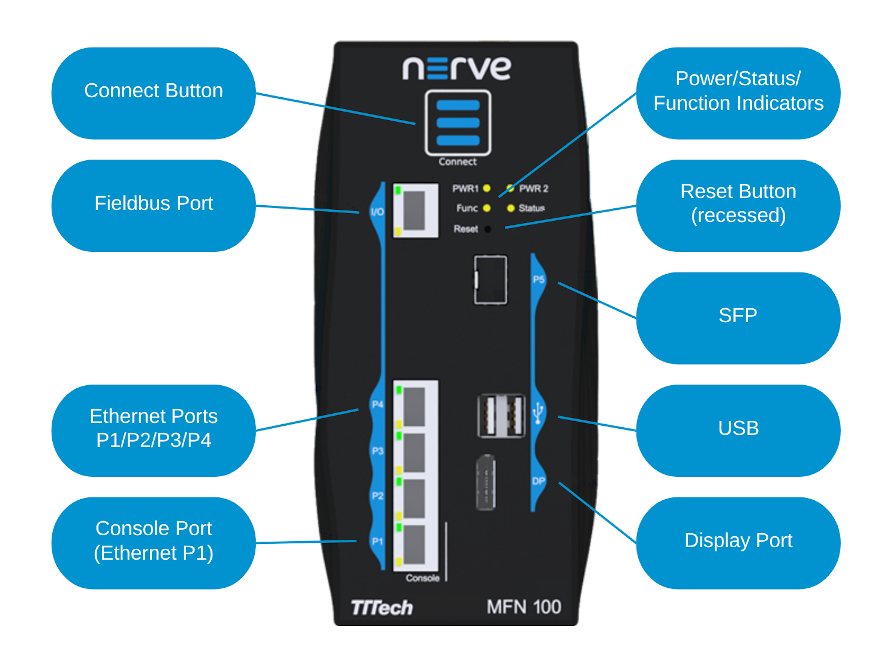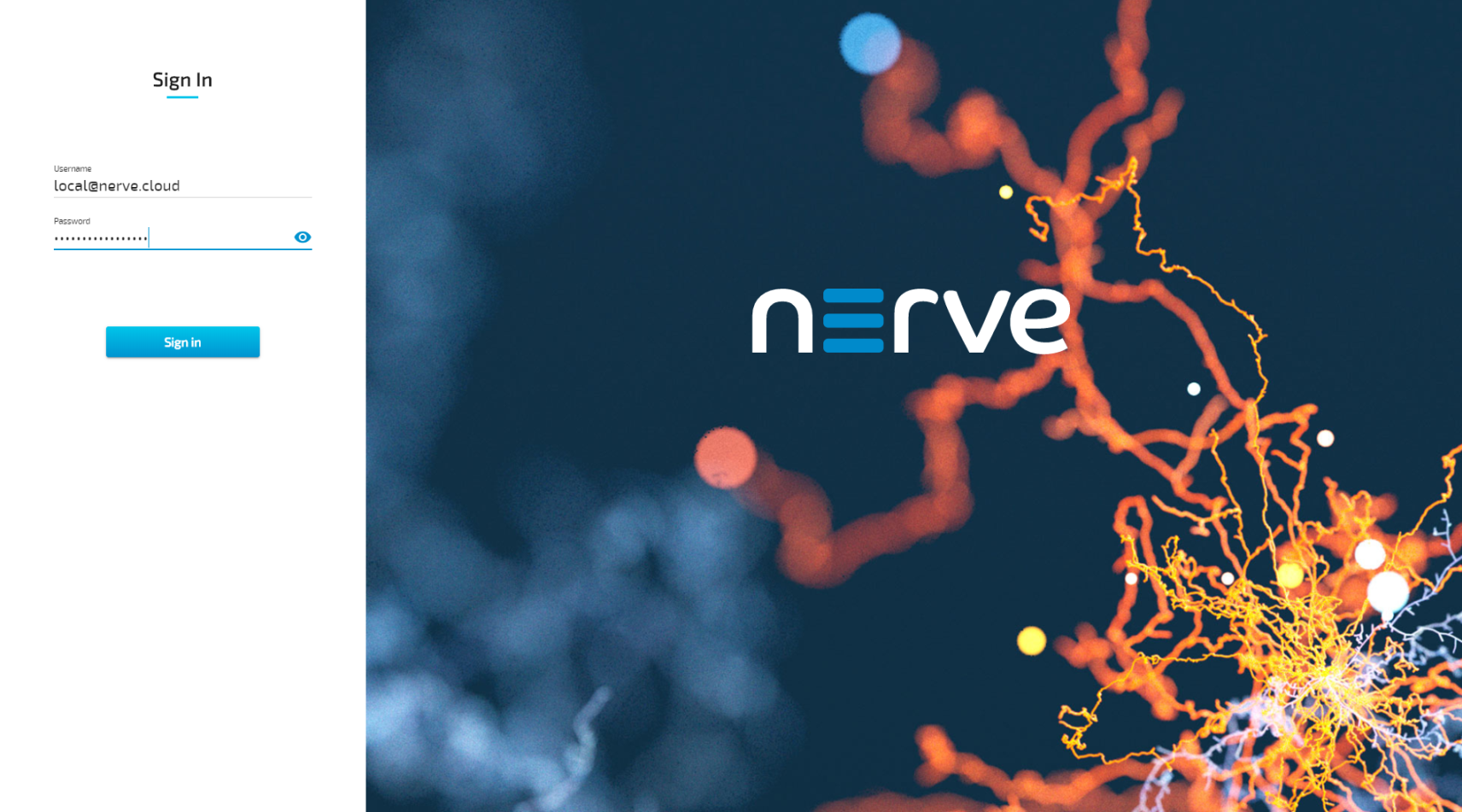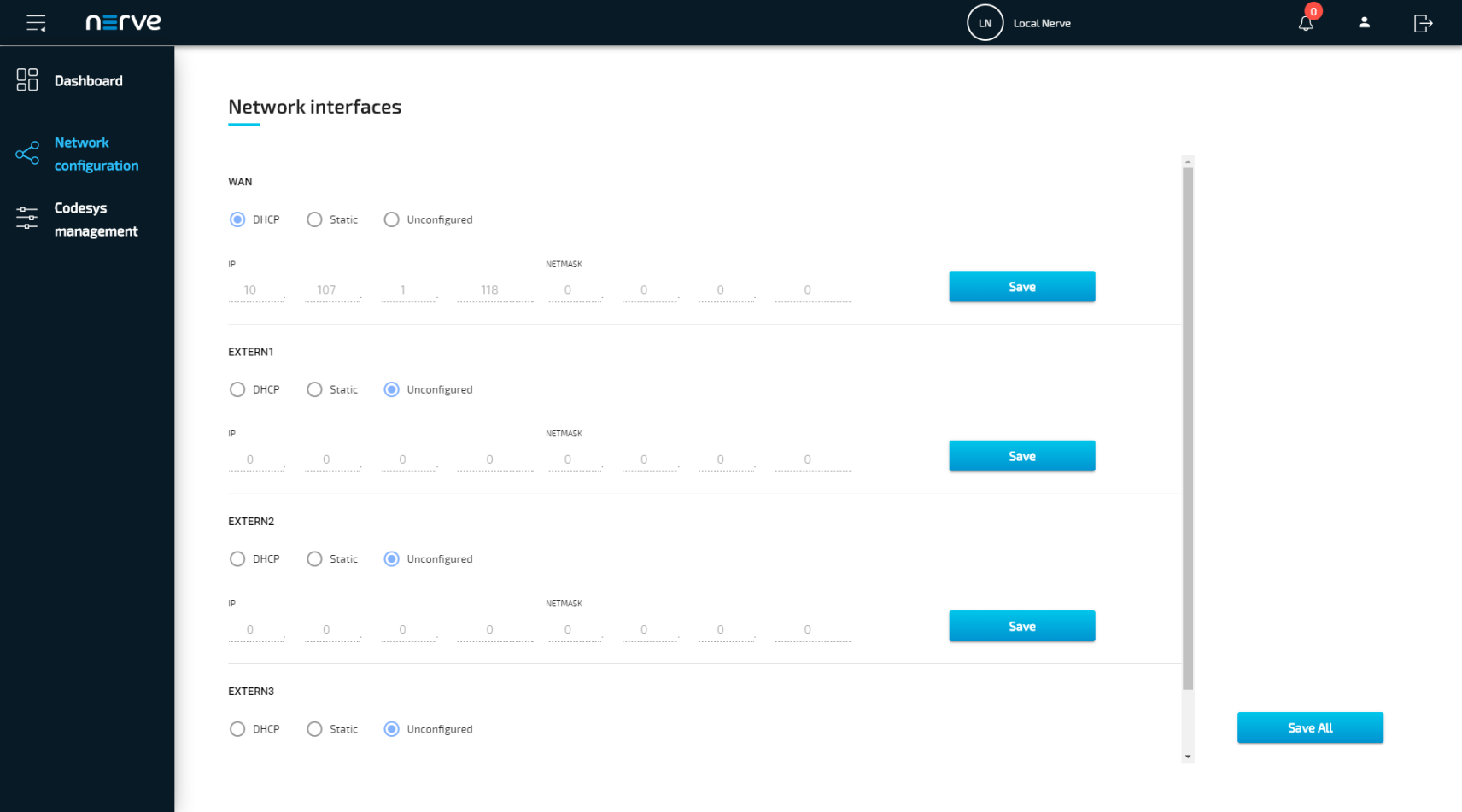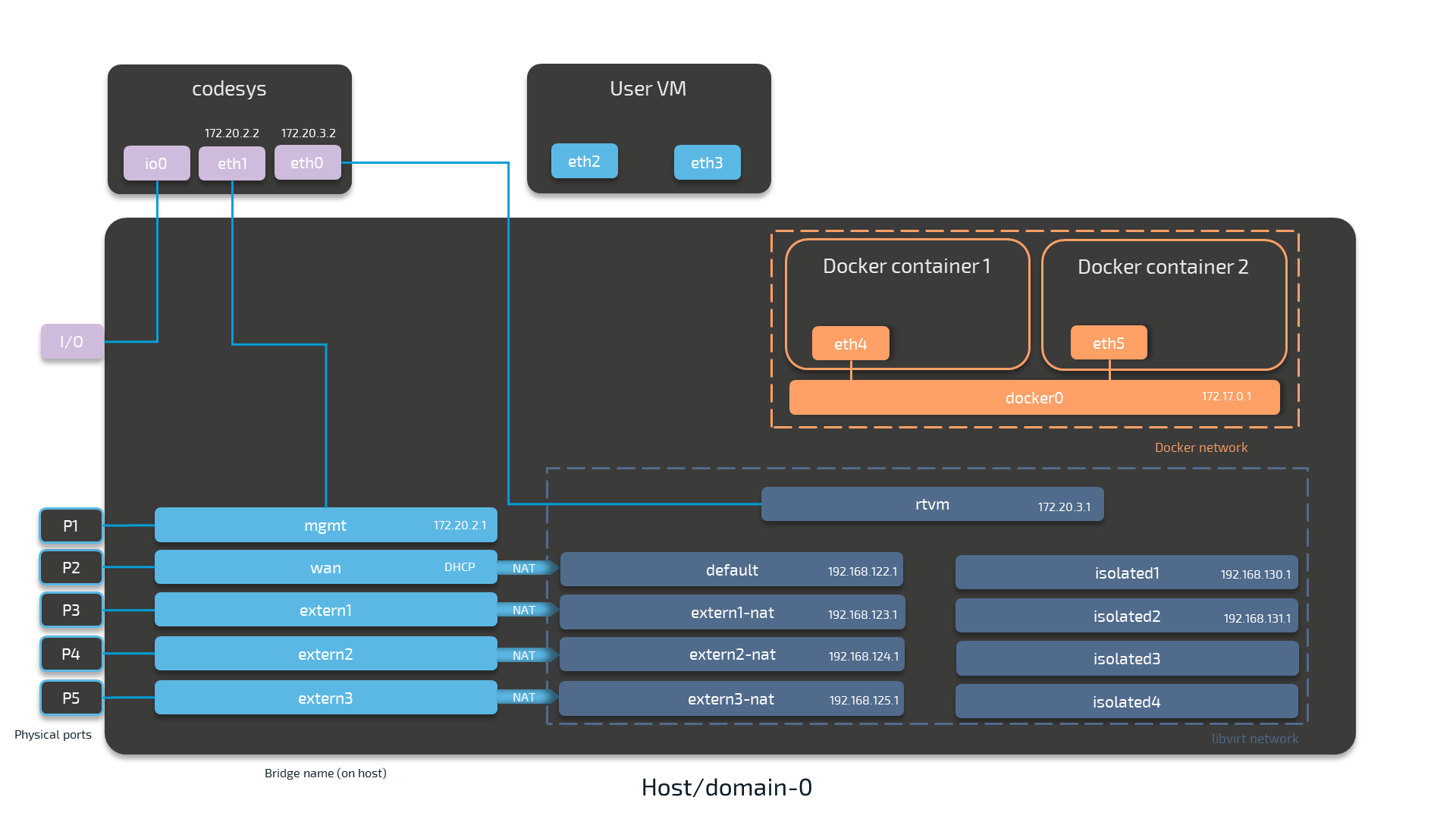MFN 100#
The MFN 100 is a qualified Nerve Device that is optimized and tested for use with Nerve software. The device is designed for use in harsh industrial environments (-40 °C to +70 °C). It is based on an Intel Atom x5-E3940/50 CPU and offers 4 GB/8 GB RAM and up to 512 GB SSD storage. The MFN 100 offers one I/O port for Ethernet-based fieldbus connectivity, four GbE switch ports and one SFP port. Additional interfaces include two USB 2.0 ports and one Display Port.
Technical Data#
| CPU | Intel E3940 4 cores, 1.8 GHz, 4 GB RAM Intel E3950 4 cores, 2.0 GHz, 8 GB RAM |
| Storage | 64 GB SSD MLC 256 GB SSD MLC 512 GB SSD MLC |
| Performance | 1 ms control cycle time achievable with Nerve Blue |
| Interfaces |
|
| Mounting | DIN rail or wall mount |
| Dimensions | (h x w x d): 179 x 87 x 143 mm |
| Weight | 2.1 kg |
| Power | 2 x 24 V redundant input, Average power consumption 12 W |
| Environmental Parameters |
|
| Certificates | CE and UL certified (EN 61000-6-2/4, IEC/UL 61010, CSA C22.2 NO. 61010-1-12) |
Hardware Overview and Setup#
Identifying the MFN 100#
The label of the MFN 100 can be found on the back of the device, close to the DIN rail clip. Exact identification is possible through the combination of product number (P/N), serial number (S/N) and version number (V/N) that are printed on the label. The model number of the MFN 100 details the variant of the MFN 100 you have purchased:
| Letter or Number | Description |
|---|---|
| CODESYS indicator | This letter indicates whether the device has a CODESYS runtime pre-configured:
|
| SSD size | This number indicates the size of the SSD:
|
| CPU variant | This indicates the CPU variant of the device:
|
Note
Please make sure to write down the serial number of your Nerve Device. You are going to need it for the node registration process.
Front Panel Controls and Indicators#
Below is an overview of the front panel of the MFN 100, describing physical interfaces, indicators and their labels.
| Label | Description |
|---|---|
| Connect Button | The connect button interrupts the connection on ports P2 to P5 of the MFN 100. This is the behavior in the standard configuration. The function is configurable on request. The button may be configured to change the network configuration. |
| Connection Indicator | The connection indicator is the first fin in the MFN 100 housing. It lights up blue when all required services are initiated and the connection to the Management System is configured. |
| Reset | Holding the button for 4-8 seconds initiates a power cycle. Use a tool with a rounded tip to press the button. |
| Power 1 Power 2 |
Indicators showing power active on the power supply. |
| Status | LED indicating system status
|
| Function | LED indicating CODESYS runtime status
|
| P1 Console | Ethernet port/console port. This port is typically used to connect a workstation to configure the MFN 100. |
| P2/P3/P4 | Ethernet ports |
| P5 | SFP port |
| I/O | Fieldbus interface |
| USB | Two USB 2.0 ports with 1.1 A maximum output current for both ports combined. |
| DP | Display Port supporting the DP++ standard. |
Power Connectors Overview#
The power connectors are located at the bottom of the MFN 100 next to the label. There are two separate 24 V inputs, two GND inputs and one Functional Earth (FE) input. The inputs are fused internally. The fuse cannot be replaced by the user. The power supply inputs are protected against reverse polarity.
| Pin | Description |
|---|---|
| 1 | Power supply line 2 |
| 2 | GND |
| 3 | GND |
| 4 | Power supply line 1 |
| 5 | Functional Earth (FE) |
Note
The GND and FE pins (pins 2, 3, and 5) are electrically connected to the housing.
Power Supply Details#
| Parameter | Value |
|---|---|
| Operating voltage | 18 - 30 VDC |
| Start-up current | 7 A max. |
| Consumption | 1.4 A continuous 2.1 A peak |
| Dissipated power | 33.6 W at 24 VDC |
Installation and Removal on a DIN Rail#
The MFN 100 is intended for mounting on a DIN rail inside a closed cabinet. Due to its weight it should be installed on a strong DIN rail. No tool is required to install or remove the MFN 100.
Follow these steps to install the MFN 100 on a DIN rail:
- Engage the DIN rail mounting clip of the MFN 100 with the upper edge of the DIN rail.
- Push the MFN 100 down into the DIN rail.
- Place the MFN 100 in a vertical position so that the mounting clip engages the lower edge of the DIN rail.
If you want to remove the MFN 100 from a DIN rail, follow these steps:
- Push the MFN 100 down.
- Rotate the MFN 100 upwards so that the lower edge of the DIN rail disengages.
- Lift the MFN 100 slightly to remove it.
Setting up the MFN 100#
After mounting the MFN 100 on a DIN rail, it is ready to be set up as a Nerve Device. You will need two network cables and a +24 V DC power supply for the setup. This includes connecting the power supply to the mating connector which is delivered with the MFN 100.
- Connect pin 1 of the mating connector to +24 V DC.
- Connect pin 2 of the mating connector to GND.
- Plug the mating connector into the bottom side of the MFN 100.
- Connect port 2 of the MFN 100 to a DHCP-enabled network with access to the Management System or internet access if the Management System is hosted by TTTech Industrial.
- Plug in the power supply.
The MFN 100 will start after a few minutes and light up blue when all necessary services are initiated.
Note
- If you are not sure how to allow external devices to connect to your network, please contact your IT administrator.
- If you want to connect the MFN 100 to a fieldbus, connect a network cable to the I/O port of the MFN 100 and to your fieldbus interface.
- You can also connect a second power supply to the MFN 100 as a backup. To do so, connect pin 3 of the mating connector to GND and connect pin 4 of the mating connector to +24 V DC.
Local UI#
As Nerve Devices have different hardware features, some configuration options differ as well. The main differences concern the local UI, networking and working with the CODESYS Development System. The local UI mostly changes according to the physical features of the Nerve Device.
Accessing the Local UI#
In order to access the local UI, you need to connect a workstation to the console port (P1) of the MFN 100 and configure the network adapter of your workstation. The IP address has to be in the range from 172.20.2.5 to 172.20.2.254 with a 255.255.255.0 subnet mask. You also need the credentials for the local UI that you can find in the customer profile.
- Follow this link to connect to the local UI: http://172.20.2.1:3000/
-
Log in with the credentials from the customer profile.
Network Configuration#
From the local UI, you can configure the Ethernet ports of the Nerve Devices. For the MFN 100, the interfaces in the local UI represent the physical ports 2, 3, 4 and 5. The console port (P1) and the I/O port of the MFN 100 are reserved and cannot be modified. The console port is used solely for configuration purposes. The I/O port is connected to the CODESYS runtime and used for fieldbus communication. Select Network configuration in the navigation on the left to reach this menu.
Available Network Interfaces#
| Interface Name | Physical Port on the MFN 100 |
|---|---|
| WAN | Ethernet port 2 (P2) |
| EXTERN1 | Ethernet port 3 (P3) |
| EXTERN2 | Ethernet port 4 (P4) |
| EXTERN3 | Ethernet port 5 (P5) |
For more information on the network interfaces and their application, please see the networking chapter in the user guide.
CODESYS Related Information#
For working with the CODESYS Development System, a device description per Nerve Device is required. The device description of the MFN 100 has been sent as part of the delivery. Please contact TTTech Industrial customer support or your sales representative if that is not the case.
The MFN 100 has an Ethernet port that is reserved for machine data acquisition. Connect a network cable to the I/O port of the MFN 100 and to your fieldbus interface to acquire machine data. The CODESYS runtime can be reached at 172.20.2.2.
Networking#
Below is a graphic that details the available interfaces of the MFN 100 for use with Nerve Blue. Pictured is how the physical interfaces translate to the Host and the CODESYS runtime.
The image below shows an example node consisting of the host/domain-0 and the real-time VM running the CODESYS runtime (labeled codesys). It also has one Virtual Machine workload and two Docker workloads deployed. The virtual machine is located outside of the host and the Docker containers are located in the Docker network inside of the host. However, the workloads are not yet connected.
| Notable IP Adresses | |
|---|---|
| Host access | 172.20.2.1 |
| CODESYS runtime access | 172.20.2.2 |
Please refer to the networking chapter in the user guide for more information on networking in the Nerve Blue system.






